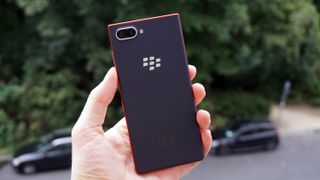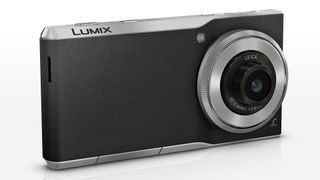5 phone brands we'd like to see make a comeback after BlackBerry
BlackBerry is coming back, but who could follow?

We were told a 5G BlackBerry phone was coming out in 2021. It would have made a pleasant break from the waves of Samsungs, Xiaomis and Motorolas we review every year. This has not panned out.
We aren’t surprised. Original owner RIM stopped being the force behind BlackBerry in 2016 when the name was licensed to Chinese tech giant TCL. TCL took a leaner approach but its reign ended in 2020, and then the brand passed on to OnwardMobility, an American company.
BlackBerry returning to the US is a refreshing change after years of Chinese brands dominating most new developments in mobile. But where TCL was already a huge manufacturing operation, OnwardMobility had to set up new manufacturing partnerships for this BlackBerry project.
We’re seeing the last bits of the BlackBerry brand squeezed from the tube here, but getting them out is harder than you might think. Could there be other phone brands out there worth bringing back to life?
Let’s dig back through the years of smartphones to find the series that might be worth a refresh while we wait to see if the 5G BlackBerry is real or 2022’s vaporware in waiting.
Wileyfox (2015-2018)

The UK’s Wileyfox lasted around three years, from 2015 to 2018, but we have some good memories of using its phones. Wileyfox made affordable Androids with surprisingly decent innards, like a OnePlus for the budget buyer. Back in 2015 Wileyfox seemed directly inspired by that company, in the CyanogenMod software and finishes it used, as well as its aggressive pricing strategy.
Now OnePlus has been subsumed into the guts of giant Oppo, we want more of that renegade spirit back in the world of phones.
Get daily insight, inspiration and deals in your inbox
Get the hottest deals available in your inbox plus news, reviews, opinion, analysis and more from the TechRadar team.
There’s even better tech for Wileyfox to use in this era too. Both MediaTek and Qualcomm now offer lower mid-range chipsets that can handle top-end games like Fortnite well, and make Android navigation feel pretty similar to that of a top-end phone.
As the CyanogenMod software has been discontinued, Wileyfox could perhaps team up with Google and make these Android One devices. Phones like the Swift 2 were real no-nonsense handsets. It would be great to see a Wileyfox Swift 3 that completely sidestepped the trend of packing the back with loads of near-useless cameras, to make something a bit more like a Pixel 4a: putting what limited budget there is into good-quality hardware, rather than a lot of the extra stuff.
Could it happen? After Wileyfox’s demise, STK took on the brand but did little with it. Now we are several years on, much of the limited brand recognition Wileyfox once had has dissipated, meaning it has likely gone for good.
Panasonic Lumix (2015)

Back in 2015 Panasonic made one of the neatest phones ever made, and hardly anyone noticed. It was the Panasonic Lumix CM1, an Android with a 1-inch camera sensor.
Only a few phones have had a sensor this large, like the Sharp Aquos R6 (only available in Japan) and the eye-wateringly expensive Sony Xperia Pro-I. The odd thing is the CM1 actually went further than that Sony phone and did it more than five years earlier.
Where the Xperia Pro-I uses a cropped portion of its 1-inch sensor, making it such in name only, the Panasonic Lumix CM1 used all 20 megapixels of the core hardware. Hardly anyone bought a CM1, to the best of our knowledge, but we’d love to see what the company’s engineers could do with a sensor of this scale matched with modern computational techniques to boost low-light performance.
We’d also have to grant Panasonic a couple of years and a few tens of millions of dollars to invest in imaging algorithms but, hey, we’re dealing in a fantasy scenario here. Or wouldn’t it be great to see Google’s engineers team up with Panasonic’s own and make the best single rear camera phone in the world?
There’s actually a quasi-distant relative of this Panasonic dream phone in existence already, the Leica Leitz Phone 1. Leica is a long-term partner of Panasonic and some of its lower-end dedicated cameras are based on Panasonic designs, tweaked with a bit of extra Leica gloss. The Leitz phone is a tweaked Sharp Aquos R6.
If Panasonic made a rival, it might result in an awkward family meet-up around the dinner table, but a little tech drama that doesn’t revolve around who exploits our data the most would make a welcome change.
Could it happen? No chance. Panasonic has spent the last few years exiting areas of business in which it can’t thrive. It abandoned telecoms in 2020, the semiconductor sector in 2019, and in 2021 announced it would stop in-house production of TVs. And Panasonic made some of the best high-end TVs in the world. Panasonic shareholders would implode if it tried to re-enter the smartphone business.
N-Gage (2002-2006)

N-Gage was a Nokia gaming phone brand from the early 2000s. It was a total flop and the name has long been the butt of jokes. But it was a neat idea that could be brought back to life beautifully in partnership with one-time Nokia proprietor Microsoft.
This is a very roundabout way of saying we want an Xbox Game Pass phone. It wouldn’t play the games. It would be a portal to stream the games over Wi-Fi and 5G, and have sturdy clip-on controllers a bit like a Nintendo Switch.
It would also be just about the only phone around with a true 1080p screen, not the ultra-tall style that has been the norm in smartphones since 2017. Without the controllers attached you’d have a stout little oddball with, let’s say, a 5.6-inch screen. We’ll call him stubby.
Slot the pads on and it becomes more like a Steam Deck you can actually fit in your pocket.
Is this a feasible idea? It’d probably have a better chance if you left out the “N-Gage” part, which would see it laughed off the internet on day one. But it could prioritize controller feel and the strength of its Wi-Fi and 5G antennas to offer a much better, and less bulky, game streaming experience than the alternatives.
While we’re here, let’s also show a little love for the N-Gage’s catalog of games. The platform was criticized for having a lame library, but it comes off rather well 10 years on.
N-Gage had Super Monkey Ball, Call of Duty, Gameloft’s Asphalt series, FIFA, Colin McRae Rally, Civilisation, Rayman 3, Sega Rally, Sonic, Tomb Raider, Virtua Tennis, Worms World Party, Splinter Cell, an Elder Scrolls game, and more. And many of these were full 3D titles, years before the Apple App Store launched. We were in an era of basic Java-based phone games in those days. You can criticize the N-Gage’s execution, but the ambition? No way.
Could it happen? With the N-Gage branding? Not a chance. The passing years has only ripened the sulfurous whiff that hangs around the name. We’d be disappointed if Microsoft hadn’t at least formulated a prototype on paper or had discussions about potential hardware partners for such a project, though. Today’s gaming phones are mostly normal phones with uglier designs. This would be something else entirely.
Palm (2009-2010)

Even mentioning the word Palm is probably enough to get you labeled a boomer these days. But you had to be there, folks. In 2009 Palm launched the Pre, a lovely little smartphone that combined the keyboard of a BlackBerry with the sort of friendly slickness you might associate with a high-end Android or iPhone.
Only a small handful of Palm models were made before the company was sold to HP. It continued the series for a brief period before coming to a strangely abrupt end. The announcement of the cancellation of the entire range was made just a day after the Palm Pre 3 was officially released.
Palm coming back to the smartphone game is a horrible, impossible idea. But we don’t hate the notion of trying for a Palm phone that adopts and re-phone’ifies the software.
You see, Palm’s phones had software called webOS. This was eventually sold to LG, which uses it for the interface of its TVs. LG has now left the smartphone business, leaving it free to license out the streaming service-packed webOS to the virtually non-existent Palm, in order to sell phones to anxious urbanites keen to get away from social media but not Netflix.
There was actually a Palm phone released not too long ago. In 2019, the Palm Phone was made by TCL under license. It was a tiny Android with rubbish battery life intended to help you trim down on your phone use, but it didn’t really do so. A “real” Palm phone could be, at the very least, bizarrely interesting.
Could it happen? The original Palm doesn’t even exist anymore. TCL’s half-hearted Palm return was a flop and the idea of re-engineering webOS back into a phone platform is, let’s be honest, ridiculous.
Dell (2010-2012)

Did you know Dell used to make phones? It was a key proponent of the ‘phablet’ trend that surfaced a few years after Android was introduced. There was the 5-inch Dell Streak, the smaller Dell Venue and the Windows phone Dell Venue Pro. They all landed in 2010 and by the end of 2012 the company had left the phone business entirely.
Why should Dell return? It honestly has little to add other than that it is an actual American company, with branding that is still respected among the tech-buying audience.
Yet, wouldn’t you consider buying a Dell XPS phone if it was just as good as the rival Samsung? Apple and Google are the only major American companies that make phones these days, now that Motorola’s phone arm is owned by Lenovo.
There’s currently no US giant that just makes phone hardware. Dell’s shareholders would hate the idea, but a return to the phone business would — strangely enough – add significantly to the diversity in the pool.
Could it happen? It would be an exceedingly bad idea for Dell to return to phones. While we can already picture a Dell XPS 6 with a sleek metal back that looks a bit like an XPS 13 laptop’s lid, the investment needed to make its cameras competitive would be huge. An Alienware (Dell’s gaming brand) phone might make more sense, but would only be interesting if it attempts something ambitious like our N-Gage Xbox Game Pass phone fantasy.
Andrew is a freelance journalist and has been writing and editing for some of the UK's top tech and lifestyle publications including TrustedReviews, Stuff, T3, TechRadar, Lifehacker and others.

Soundcore's new sports earbuds offer a Powerbeats Pro-style customizable secure fit for a fraction of the price

Meta’s massive OS announcement is more exciting than a Meta Quest 4 reveal, and VR will never be the same again

World's fastest broadband connection went live down under — Nokia demos 100 gigabit internet line in Australia in record-breaking attempt but doesn't say when it will go on sale
